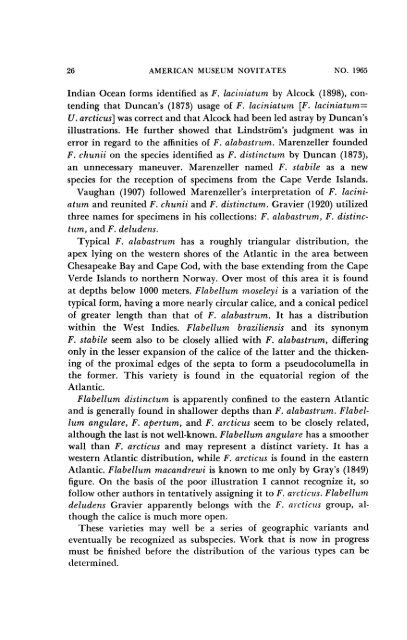MXieuicanJAuscum - American Museum of Natural History
MXieuicanJAuscum - American Museum of Natural History
MXieuicanJAuscum - American Museum of Natural History
You also want an ePaper? Increase the reach of your titles
YUMPU automatically turns print PDFs into web optimized ePapers that Google loves.
26 AMERICAN MUSEUM NOVITATES<br />
NO. 1965<br />
Indian Ocean forms identified as F. lacinziatutm by Alcock (1898), contending<br />
that Duncan's (1873) usage <strong>of</strong> F. laciniatum [F. laciniatum=<br />
U. arcticus] was correct and that Alcock had been led astray by Duncan's<br />
illustrations. He further showed that Lindstrom's judgment was in<br />
error in regard to the affinities <strong>of</strong> F. alabastrum. Marenzeller founded<br />
F. chunii on the species identified as F. distincturn by Duncan (1873),<br />
an unnecessary maneuver. Marenzeller named F. stabile as a new<br />
species for the reception <strong>of</strong> specimens from the Cape Verde Islands.<br />
Vaughan (1907) followed Marenzeller's interpretation <strong>of</strong> F. laciniatutm<br />
and reunited F. chunii and F. distinctum. Gravier (1920) utilized<br />
three names for specimens in his collections: F. alabastrum, F. distincturm,<br />
and F. deludens.<br />
Typical F. alabastrum has a roughly triangular distribution, the<br />
apex lying on the western shores <strong>of</strong> the Atlantic in the area between<br />
Chesapeake Bay and Cape Cod, with the base extending from the Cape<br />
Verde Islands to northern Norway. Over most <strong>of</strong> this area it is found<br />
at depths below 1000 meters. Flabellum rnoseleyi is a variation <strong>of</strong> the<br />
typical form, having a more nearly circular calice, and a conical pedicel<br />
<strong>of</strong> greater length than that <strong>of</strong> F. alabastrum. It has a distribution<br />
within the West Indies. Flabellum braziliensis and its synonym<br />
F. stabile seem also to be closely allied with F. alabastrum, differing<br />
only in the lesser expansion <strong>of</strong> the calice <strong>of</strong> the latter and the thickening<br />
<strong>of</strong> the proximal edges <strong>of</strong> the septa to form a pseudocolumella in<br />
the former. This variety is found in the equatorial region <strong>of</strong> the<br />
Atlantic.<br />
Flabellum distinctum is apparently confined to the eastern Atlantic<br />
and is generally found in shallower depths than F. alabastrum. Flabellum<br />
angulare, F. apertum, and F. arcticus seem to be closely related,<br />
although the last is not well-known. Flabellum angulare has a smoother<br />
wall than F. arcticus and may represent a distinct variety. It has a<br />
western Atlantic distribution, while F. arcticus is found in the eastern<br />
Atlantic. Flabellum macandrewi is known to me only by Gray's (1849)<br />
figure. On the basis <strong>of</strong> the poor illustration I cannot recognize it, so<br />
follow other authors in tentatively assigning it to F. arcticus. Flabelltrn<br />
deludenis Gravier apparently belongs with the F. arcticuis group, although<br />
the calice is much more open.<br />
These varieties may well be a series <strong>of</strong> geographic variants and<br />
eventually be recognized as subspecies. Work that is now in progress<br />
must be finished before the distribution <strong>of</strong> the various types can be<br />
(letermine(l.
















